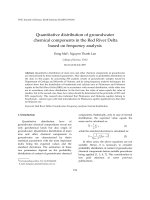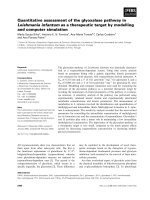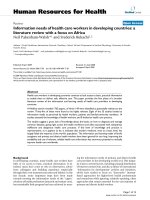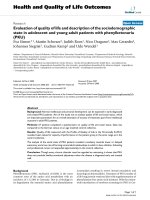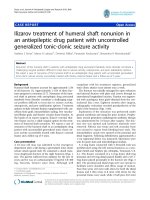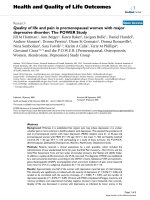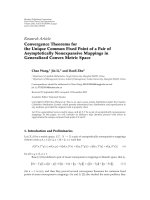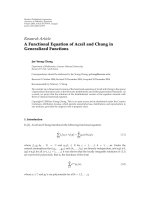Quantitative result of serotonin plasma concentrations in generalized tonic clonic seizure patients with combined depressive disorder
Bạn đang xem bản rút gọn của tài liệu. Xem và tải ngay bản đầy đủ của tài liệu tại đây (73.18 KB, 4 trang )
Journal of military pharmaco-medicine n08-2017
QUANTITATIVE RESULT OF SEROTONIN PLASMA
CONCENTRATIONS IN GENERALIZED TONIC-CLONIC
SEIZURE PATIENTS WITH COMBINED DEPRESSIVE DISORDER
Pham Van Thang*; Bui Quang Huy**; Ngo Ngoc Tan**
SUMMARY
Objectives: To evaluate quantitative results of serotonin plasma concentrations in generalized
tonic-clonic seizure patients with combined depression. Subjects and methods: A cross-sectional
study of serotonin serum concentrations at T0 (start of study) and T8 (after 8 weeks of treatment)
is the result of random selection of 88 out of 102 generalized tonic-clonic seizure patients with
combined depression at Haiphong Psychiatric Hospital from April, 2013 to October, 2015.
Results: Serotonin in the average plasma concentration at time T0 was 42.30 ± 24.46 ng/mL,
at the time T8 79.39 ± 67.87 ng/mL. The relationship between serotonin serum and some
generalized tonic-clonic seizures with combined depression such as: the mild depression was
(47.69 ± 38.77 ng/mL) higher than the severe depression (37.06 ± 17.57 ng/mL). Conclusion:
There is not difference in plasma serotonin levels with clinical manifestations of organic depressive
disorder, duration of depression, duration of epilepsy.
* Keywords: Generalized tonic-clonic seizures; Depressive disorder; Serotonin concentration.
INTRODUCTION
People with epilepsy often have
accompanied depressive disorders. Serotonin
levels in plasma are thought to be
associated with depressive disorder, and
in depressed patients, these levels are
markedly lower than those of normal
people, sometimes as high as 30%. In
Vietnam, quantitative serotonin levels in
epilepsy patients with depression have
not yet been studied. With such importance,
the objectives of this study is: Evaluate
quantitative results of serotonin plasma
concentrations in generalized tonic-clonic seizure
patients with combined depressive disorder.
SUBJECTS AND METHODS
1. Subjects.
88 inpatients with generalized tonic-clonic
seizures who have depressive cormibined
disorder, were treated at Haiphong Mental
Hospital from April, 2013 to October,
2015.
2. Methods.
Cross-sectional descriptive study.
- Use the diagnostic criteria G40.6 of
ICD-10 (1992) for generalized tonic-clonic
seizure section and diagnostic criteria F06.32
for organic depressive disorder.
* Haiphong Mental Hospital
** 103 Military Hospital
Corresponding author: Bui Quang Huy ()
Date received: 10/08/2017
Date accepted: 21/09/2017
203
Journal of military pharmaco-medicine n08-2017
- Test serotonin concentrations in 88 patients with ELISA at time T0 (start of study)
and T8 (after 8 weeks of treatment).
- The data was processed and analyzed on standa 12.0 program.
RESULTS AND DISCUSSION
Table 1: Serotonin levels in generalized tonic-clonic seizure patients with combined
depressive disorder at T0 and T8.
Serotonin levels
n
Average value
(ng/mL)
Maximum value
(ng/mL)
Minimum value
(ng/mL)
T0
88
42.30 ± 24,46
139.74
24.61
T8
88
79.39 ± 67,87
407.67
25.68
Time
p
< 0.001
Serotonin levels at T0: 42.30 ± 24.46 ng/mL, while at T8: 79.39 ± 67.87 ng/mL,
comparing these two times showed that serotonin level was higher and statistically
significant (p < 0.001) (t = -5.12, p = 0.000). According to Dao Van Phan (1998),
serotonin level in healthy human blood was about 0.06 - 0.22 µg/mL [1]. Saldanha B.D
et al (2009) researched on 40 depressed patients treated with fluoxetine, sertraline,
citalopram and paroxetine and found that serotonin concentration in plasma before
intervention was 73.75 ng/mL and increased to 127.93 ng/mL after intervention [4].
Table 2: Relationship between serotonin levels and depressive disorder.
Evaluative index
n = 88
Proportion (%)
Serotonin level (ng/mL)
Mild
7
7.95
47.69 ± 38.77
Moderate
62
70.45
43.30 ± 24.52
Severe
19
21.60
37.06 ± 17.57
Depressive disorder
p
F = 0.65; p = 0.5230
The highest of serotonin level was at mild depressive disorder group (47.69 ±
38.77 ng/mL) and the lowest of serotonin level was at severe depressive disorder
group (30.06 ± 17.57 ng/mL). Analysis of ANOVA variance showed that serotonin level
were not statistically significant (p > 0.05) (F = 0.65; p = 0.5230). Wulsin L.R et al (2009)
found serotonin levels in patients presenting with depression were 139 ± 6.5 ng/mL, a history
of depression of 120 ± 5.0 ng/mL and no history of depression 119 ± 3.1 ng/mL [6].
204
Journal of military pharmaco-medicine n08-2017
Table 3: Relationship between serotonin levels in plasma and classification of
depressive disorder.
Evaluative index
n = 88
Proportion
(%)
Serotonin level
(ng/mL)
Depressive episode (F32)
81
92.05
42.62 ± 25.25
Recurrent depressive disorder (F33)
7
7.95
38.52 ± 12.29
Classifications of depressive disorder
p
t = 0.4241; p = 0.6726
Serotonin plasma concentrations in patients with depressive episode were 42.62 ±
25.25 ng/mL with recurrent depressive disorder: 38.52 ± 12.29 ng/mL. When comparing two
groups, there was no significant difference (p > 0.05) (t = 0.4241; p = 0.6726).
Ruljancic N et al (2013) studied the quantification of serotonin levels in platelets by
immunoassay (ELISA), the result of self-deprecated depression: 176 ng/109 plt, suicidal
ideation group: 227 ng/09 plt, control group: 502 ng/109 plt [5].
Table 4: Relationship between serotonin plasma concentrations and duration of
depressive disorder.
Statistic index
n = 88
Proportion (%)
Serotonin level
(ng/mL)
Over 1 month to 3 months
8
9.09
28.49 ± 1.80
Over 3 months to 6 months
29
32.95
37.45 ± 14.94
Over 6 months to 9 months
22
25.00
42.36 ± 26.06
Over 9 months to 12 months
26
29.55
52.99 ± 32.25
> 12 months
3
3.41
32.81 ± 4.82
Duration of depressive disorder
p
F = 2.43; p = 0.0543
The highest serotonin level was 52.99 ± 32.25 ng/mL and the lowest serotonin level
was 28.49 ± 1.80 ng/mL. Analysis of single-element variance using the ANOVA method
showed that there were no statistically significant differences (p > 0.05) (F = 2.43;
p = 0.054). Vuong Van Tinh (2011) found no correlation between serotonin levels and
the duration of disease in patients with severe depression. Specifically, the duration
≤ 12 months: 4.00 ± 1.43 ng/mL, 13 - 24 months: 5.79 ± 2.68 ng/mL, 25 - 36 months:
3.3 ± 2.23 ng/mL, > 36 months: 5.60 ± 2.11 ng/mL [2].
205
Journal of military pharmaco-medicine n08-2017
Table 5: Relationship between serotonin
concentration in plasma and duration of
epilepsy.
Statistic index
Duration
of epilepsy
n = 88 Proportion
(%)
Serotonin
level
(ng/mL)
≤ 5 years
8
9.09
35.805 ±
24.26
6 - 10 years
8
9.09
45.74 ±
23.92
11 - 15 years
16
18.18
41.36 ±
27.28
16 - 20 years
18
20.45
37.51 ±
14.70
21 - 25 years
12
13.64
52.66 ±
32.14
26 - 30 years
7
7.95
34.54 ±
9.20
> 30 years
19
21.59
45.22 ±
28.36
p
p = 0.3948
Plasma concentrations of serotonin was
the highest in the group of 21 - 25 years
(52.66 ± 32.14 ng/mL), and the lowest in
group of 26 - 30 years (34.54 ± 9.20 ng/mL).
When analyzing ANOVA variance, we
found that the difference between groups
was not statistically significant (p > 0.05)
(p = 0.3948). We did not find direct
comparative data with other authors on
the relationship between serotonin plasma
concentrations and time of epilepsy.
Arbatova J et al (2005) found that the
plasma concentrations of tryptophan in
the epileptic seizure with an average age
of 33 ± 5 years were (33.08 ± 3.2 µg)
lower than those of the healthy controls
(control group) (78.8 ± 4.4 µg) [3].
CONCLUSION
- Serotonin levels at time T0 was 42.30 ±
24.46 ng/mL and after 8 weeks of treatment
with fluoxetine in combination with antiepileptic
drugs (at T8) was 79.39 ± 67.87 ng/mL.
206
- Serotonin levels in plasma were the
highest in mild depressive disorder (47.69 ±
38.77 ng/mL) and the lowest in severe
depressive disorder (30.06 ± 17.57 ng/mL).
- Serotonin levels in patients with depressive
episode was 42.62 ± 25.25 ng/mL and
with recurrent depressive disorder was
38.52 ± 12.29 ng/mL.
- There was no difference between
serotonin level and duration of depression.
- There is no difference between serotonin
level and duration of epilepsy.
REFERENCES
1. Phan Van Dao. Serotonin in: Pharmacology.
Medical Publishing House. Hanoi. 1998,
pp.563-556.
2. Vuong Van Tinh. Research on clinical
characteristics and related factors in patients
with major depressive disorder. Medical
Doctorate thesis. Vietnam Military Medical
University. 2011.
3. Arbatova J, Amato E, Vaarmann A et al.
Reduced serotonin and 3-hydroxyanthranilic
acid levels in serum of cystatin B-deficient
mice, a model system for progressive myoclonus
epilepsy. Epilepsia. 2005, 46 (5), pp.49-51.
4. Saldanha B.D, Kumar M.N et al. Serum
serotonin abnormality in depression. Medical
Journal Armed Forces India. 2009, 65,
pp.108-112.
5. Ruljancic N, Mihanovic M, Cepelak I et al.
Platelet serotonin and magnesium concentrations
in suicidal and non-suicidal depressed patients.
Magnesium Research. 2013, 26 (1), pp.9-17.
6. Wulsin L.R, Musselman D, Otte C et al.
Depression and whole blood serotonin in patients
with coronary heart disease from the heart
and soul study. PsychosomaticMedicine. 2009,
71 (3), pp.260-265.

